Halloween originated around 2,000 years ago to the Celtic festival of Samhain. The Celts celebrated the New Year on November 1st where they would light bonfires and wear costumes to ward off evil spirits.
October 31st was considered to mark the official last day of summer and the beginning of winter. The Celts believed that on this night, the line between the spiritual and physical realm become blurred, which gives spirits an opportunity to walk the earth. The Celtic priests would light giant sacred bonfires and attempt to tell other's fortunes, as they believed the ghosts would make predicting the future possible. In addition to the celebration of the New Year, the winter season was often associated with famine or human death. After the Samhain celebration was complete, the priests would relight the fires to keep everyone warm.
The Halloween tradition began in Ireland and northern France and was kept limited due to the belief system at the time. As different European ethnic groups came to America, the Americans began to celebrate their own version of Samhain in ways that included storytelling, future telling, singing, and dancing. By the mid-nineteenth century, Halloween celebrations were more common in America but not yet celebrated across the country. When the Irish Potato Famine struck, the immigrants that migrated to America helped popularize the Halloween celebration.
As the celebration of Halloween became more popular, more people thought that they would be able to tell the future by performing various actions like witchcraft. However, there was a move in America where they wanted to make the Halloween celebration more neighborly instead of frightful, so they discouraged the grotesque and unpleasant side of Halloween. Halloween parties were the most common way to celebrate and they focused on games, costumes, and seasonal food. By the mid-twentieth century, Halloween lost most of its superstition and religious background. The different belief systems and interpretations of a Halloween celebration is likely the reason why there is such a variety in the Halloween spook factor.
People began trick-or-treating by deciding to take the tradition of dressing in costume but instead of warding off evil spirits, they went from door to door asking for money or food. In the mid-twentieth century, America realized that buying candy was a relatively cheap way of celebrating a holiday with the entire community. This was the beginning of today's Halloween tradition that has only grown ever since.
- The Fascinating History of Halloween - Where Did Halloween Come ... ›
- Halloween History | National Geographic - YouTube ›
- Halloween: Origins & Traditions - HISTORY ›
- History of Halloween - Halloween Meaning and Origin ›
- The dark history of Halloween traditions - Business Insider ›
- The Origin of Halloween—Where Does It Come From? | Bible ... ›















